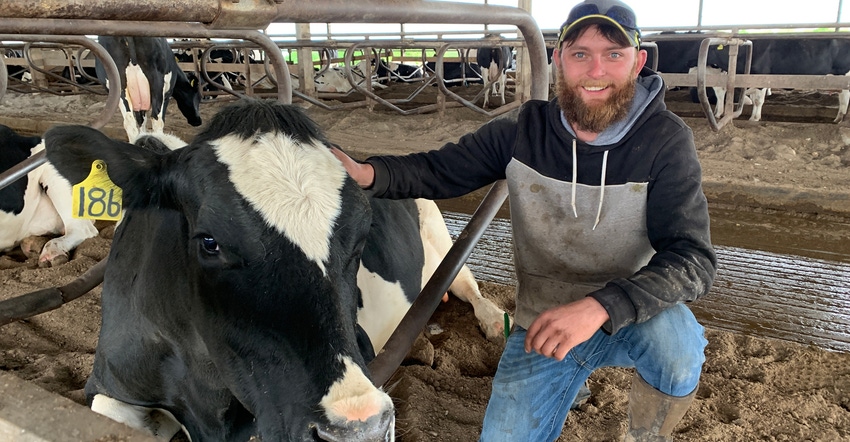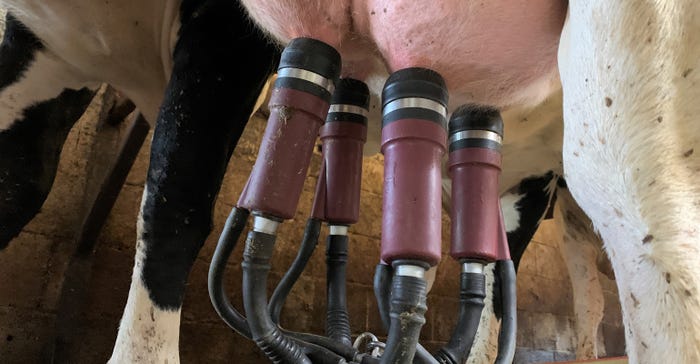
Dreary gray overcast skies start to gently sprinkle rain as Adam Mareth emerges from the milk house. Cow manure decorates his shirt, and mud lingers on his muck boots.
The young dairy farmer was up early checking on employees milking cows and working with an electric contractor to fix cooling fans. With a quick swipe of his hand across his jeans, he offers a firm handshake and begins to share his dairy farm story.
For some young people, returning to the farm is a passion. For others, it is a distant dream, and then there are those it is thrust upon out of necessity. The latter is Mareth.
Growing up on the dairy farm, he followed his dad around tending to the dairy cows and crops on their farm outside of Monett, Mo. After high school, the young man attended college to become a diesel mechanic and spent time in town turning wrenches. “Then my dad had a stroke in 2017,” he says. “I’ve been here ever since.”
Mareth’s grandfather started the family dairy legacy in northern Illinois in 1954. “Grandpa got tired of the cold and moved south,” he says. They’ve been farming in southwest Missouri since the early 1970s.
His father, Tom, took over the Barry County operation in 1990 through a lease agreement. “That’s when things started to take off. Dad increased the herd size, and he changed management practices and started increasing milk production per cow,” Mareth explains. “He tried to streamline everything and built it up to milking the 200-cow mark.”
By 2000, the family built a freestall barn. “He didn’t know if any of us were going to try to take over and grow the farm, so he just stopped adding on. Then he had his stroke," Mareth says.
Responsibility, ready or not
At that time, Mareth was only 22 years old. He returned to the farm. It was right in the middle of corn planting season. “I knew how to plant,” he explains. “My dad was pretty much in the hospital while we were doing all that, but I didn’t have a clue how to run a sprayer.”
So, he called the neighbors, talked to his dad and simply figured it out. “It was then I realized all the stuff you learn in high school that you didn’t think you’d ever need to remember, all the math that went along with it, is now a really big deal," he says. He made it through. “I’ve kind of taken the farm by the horns and just been going with it.”
Today, he is the third generation to run Mareth Dairy, which includes management of six employees. One has been around since Mareth was born. Two other employees responsible for milking cows are twice his age. The remaining employees are younger than Mareth.

MILKING DAYS: The milking parlor at Mareth Dairy includes a double-six herringbone parlor, allowing employees easy access to cows. Next-generation dairy farmer Adam Mareth hopes to build a new parlor as he expands the milking herd.
Open communication keeps the operation running smoothly. Cows are milked three times a day and maintain the farm’s 25,000 rolling herd average. “We try to stay pretty steady, but this time of year with the weather flopping around — last week it was 80 degrees, and now it's 40 — the cows don’t like that," Mareth says. "Weather messes with milk production.” Milk is sold through Dairy Farmers of America.
Mareth is responsible for all breeding. He uses artificial insemination, another on-farm learned skill. When a dairy farm down the road was training some of its employees on AI, Mareth tagged along. Since then, he’s bred up to 1,500 cows. The farm purchases sexed semen to yield heifers, which they raise and introduce back into the herd. Mareth’s fiancée, Stephanie Kaiser, is integral to this aspect of the farm, caring for the young dairy calves.
When it comes to developing feed rations, Mareth turns to a nutritionist. He also reaches out to University of Missouri Extension dairy specialist Reagan Bluel to ask questions and discuss ideas. “She is very well-rounded on knowledge, but especially understands dairy,” he notes. “She’s very good at repo and helped me a lot to develop my systems here.”
It is a lot of responsibility for the young dairy farmer. “This is a 24-hour-a-day job,” he notes. “Some mornings I get rolled out of bed at 2 a.m.; some days I get to sleep in until 8:30. Sometimes I work till midnight. It just depends on what needs to be done.”
The workload does not deter Mareth from dairying. And a similar agreement that his father had with his grandfather is helping to secure his place in the industry.
Road to ownership
There are three other brothers in Mareth’s family. They have not expressed interest in the dairy farm. “But the option to buy in has been there,” he says.
Currently, the dairy farm includes cows, land, equipment and buildings, which will transition to Mareth through a lease agreement. It is similar to the lease-to-buy options seen in residential home transactions. But each aspect of the farm is on its own lease with its own time frame.
“In three years, I will be able to own the cows,” he explains. “And then after that, we’ll step up to machinery. The last thing I will own is the ground.”
He finds this type of lease “advantageous for both parties.” Mareth can gain control of more assets each year, while his father continues to earn an income from the operation.

DAIRY BARN: Mareth Dairy added a freestall barn about 20 years ago. Adam Mareth says cow comfort is key to milk production. The barn’s sand bedding is turned daily.
The succession plan provides the young dairy farmer the opportunity to plan for the future. Ultimately, Mareth would like to increase the size of the herd to about 600 milking cows and upgrade his double-six herringbone parlor in the next 10 years.
The circumstances of his father’s stroke that brought Mareth back to the farm were not ideal. However, the young farmer is taking every advantage of creating an efficient, sustainable dairy farm in southwest Missouri.
“I found, I like being my own boss,” he says. “I’m working for something to call my own. Yes, there are a lot of responsibilities, a lot of hard work, but I found the path to not having to work for somebody else, and I like that.”
About the Author(s)
You May Also Like






